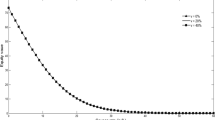Abstract
We propose a structural model with a joint process of tangible assets (marker) and firm status for the pricing of corporate securities. The firm status is assumed to be latent or unobservable, and default occurs when the firm status process reaches a default threshold at the first time. The marker process is observable and assumed to be correlated with the latent firm status. The recovery upon default is a fraction of tangible assets at the time of default. Our model can evaluate both the corporate debt and equity to fit their market prices in a unified framework. When the two processes are perfectly correlated, our model is reduced to the seminal Black–Cox model. Numerical examples are given to support the usefulness of our model.
Similar content being viewed by others
References
Altman EI (1968) Financial ratios, discriminant analysis and the prediction of corporate bankruptcy. J Financ 23: 589–609
Black F, Cox J (1976) Valuing corporate securities: some effects on bond indenture provisions. J Financ 31: 351–367
Briys E, de Varenne F (1997) Valuing risky fixed debt: an extension. J Financ Quant Anal 32: 239–248
Chen N, Kou S (2005) Credit spreads, optimal capital structure, and implied volatility with endogenous default and jump risk. Working paper, Columbia University
CreditMetricsTM (1997) JP Morgan
Fons JS (1994) Using default rates to model the term structure of credit risk. Financ Anal J September-October:25–32
Giesecke K (2004) Correlated default with incomplete information. J Bank Financ 28: 1521–1545
Jarrow RA, Turnbull SM (1995) Pricing derivatives on financial securities subject to credit risk. J Financ 50: 53–86
Karatzas I, Shreve SE (1988) Brownian motion and stochastic calculus. Springer, Heidelberg
Kijima M (1998) Monotonicities in a Markov chain model for valuing corporate bonds subject to credit risk. Math Financ 8: 229–247
Kijima M, Suzuki T (2001) A jump-diffusion model for pricing corporate debt securities in a complex capital structure. Quant Financ 1: 611–620
Lee T, DeGruttola V, Schoenfeld D (2000) A model for markers and latent health status. J R Stat Soc 62: 747–762
Leland H (1994) Corporate debt value, bond covenants, and optimal capital structure. J Financ 49: 1213–1252
Longstaff F, Schwartz E (1995) A simple approach to valuing risky fixed and floating rate debt. J Financ 50: 789–819
Madan D, Unal H (2000) A two-factor hazard rate model for pricing risky debt and the term structure of credit spreads. J Financ Quant Anal 35: 43–65
Mella-Barral P, Perraudin W (1997) Strategic debt service. J Financ 52: 531–556
Merton RC (1974) On the pricing of corporate debt: The risk structure of interest rates. J Financ 29: 449–470
Merton RC (1976) Option pricing when underlying stock returns are discontinuous. J Financ Econ 3: 125–144
Whitmore GA, Crowder MJ, Lawless JF (1998) Failure inference from a marker process based on a bivariate Wiener model. Lifetime Data Anal 4: 229–251
Zhou C (2001) The term structure of credit spreads with jump risk. J Bank Financ 25: 2015–2040
Author information
Authors and Affiliations
Corresponding author
Rights and permissions
About this article
Cite this article
Kijima, M., Suzuki, T. & Tanaka, K. A latent process model for the pricing of corporate securities. Math Meth Oper Res 69, 439–455 (2009). https://doi.org/10.1007/s00186-008-0246-5
Received:
Accepted:
Published:
Issue Date:
DOI: https://doi.org/10.1007/s00186-008-0246-5




